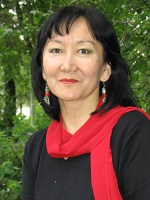Toponimic Legends of South-Eastern Tuva
DOI:
https://doi.org/10.25178/nit.2018.3.9Keywords:
Tuva; Tuvan folklore; Tuvan language; toponymics; toponymical legends; south-eastern Tuva; Erzin kozhuun; Tes-Khem kozhuun; ethnocultural contacts; Western Mongolia; Mongolia; Mongolian languageAbstract
The article analyses the local uniqueness of plots and motives in toponymic legends of south-eastern Tuva: Tes-Khem, Erzin, and Tere-Khol kozhuuns (rayons), also considering the context of ethnocultural contacts between south-eastern Tuvans and their Mongolian neighbors. South-eastern Tuva is a territory of Tuvan-Mongolian bilingualism which has become ingrained in local culture. The materials for the study are the legends published in various collections of Tuvan folklore, as well as field records of the joint Tuvan-Mongolian research expedition in Erzin district in 2011 wherein the author was involved.
South-eastern Tuva is inhabited by houses (clans) of Kyrgys, Soyan, and Choodu, all of which exhibit various degrees of Tuvan-Mongolian bilingualism. The use of Mongolian language amongst them is a cultural relic.
In oral tradition of south-eastern Tuvan legends (toolchurgu chugaa), historical narratives (toogu chugaa) and spoken stories (bolgan tavarylga) are widespread. Toponymic legends or stories explaining origin of names of various geographical places are a big part of them. Their typical features are absence of well-defined composition structure, a single episode, localization of place and time of the event, a reference to specific witnesses or participants, focus on historicism and authenticity of information. A common plot of toponymic legends involves a territorial argument between Tuvans and Mongolians about pasture grounds. Typical plots can be found in the legends of the origin of the names of local mountains Ulug-Khaiyrakan, Kyrgys-Tei, Kezhege, etc; names of lakes Tore-Khol and Tere-Khol.
The toponymic legends covered in the article are important for the preservation of the ancient names of numerous geographical places, mountains, rivers, lakes and nomadic territories which now are located on the territory belonging to a foreign state where they have probably been forgotten or renamed. Recording such legends is important both for the oral history of some Tuvan clans and as an illustration of tight historical contacts in the borderlands between Tuva and Mongolia.
References
Vainshtein, S. I. (1957) Ob istoricheskikh granitsakh rasseleniia kyrgyzov v Iuzhnoi Sibiri [On the historical boundaries of the settlement of the Kyrgyz people in southern Siberia]. Uchenye zapiski TNIIIaLI, vol. V. Kyzyl, Tuvinskoe knizhnoe izdatel'stvo. Pp. 215–219. (In Russ.).
Grebnev, L. V. (1960) Naselenie Tuvy v nachale XIII v. [The population of Tuva in the early 13th century]. Uchenye zapiski TNIIIaLI, vol. VIII. Kyzyl, Tuvinskoe knizhnoe izdatel'stvo. Pp. 164–165. (In Russ.).
Dongak, A. S. (2015) Siuzhetno-tematicheskie tsikly toponimicheskikh predanii Iugo-Vostochnoi Tuvy [Thematic cycles of toponymic legends of South-Eastern Tuva]. REOSIAHAG. Journal of Institute for Russian and Altaic Studies, no. 11, February, pp. 213–228. (In Russ.).
Dongak, A. S. (2016) Toponimicheskie predaniia i legendy Iugo-Vostochnoi Tuvy: lokal'noe svoeobrazie v rusle mezhkul'turnykh kontaktov [Toponymic legends and tales of South-Eastern Tuva: local identity in the mainstream of intercultural contacts]. In: I Sibirskii forum fol'kloristov [I Siberian forum of folklorists]: abstracts / ed. by E. N. Kuz'min. Novosibirsk, OOO «Akademizdat». 188 p. Pp. 54–56. (In Russ.).
Istoriia Tuvy [The History Of Tuva] (2001) / ed. by V. A. Lamin. 2nd ed. Novosibirsk, Nauka. 366 p. (In Russ.).
Kuular, D. S. (1996) Kys-Khalyyr: Tyva ulustuң toolchurgu bolgash tөөgү chugaalarynyң chyyzhyzynyң katap үndүrүlgezi [Rock girls: Tuvan folk legends and legends] / Kuular D. S. and Kuular Ch. Ch. Kyzyl, Tuvinskoe knizhnoe izdatel'stvo. 157, [2] p. (In Tuv.).
Mannai-ool M. Kh. (2004) Tuvintsy: proiskhozhdenie i formirovanie tuvinskogo etnosa [Tuvans: the origin and formation of the Tuvan ethnos]. Novosibirsk, Nauka. 166 p. (In Russ.).
Mir Ubsunurskoi kotloviny [The world of Ubsunur Hollow] (1994) : album. Novosibirsk, SO RAN Publ. 155 p. (In Russ.).
Prokof'eva, E. D. (2011) Protsess natsional'noi konsolidatsii tuvintsev [The Process of National Consolidation of the Tuvans]. St. Petersburg, Nauka. 538 p. (In Russ.).
Serdobov, N. A. (1971) Istoriia formirovaniia tuvinskoi natsii [The history of the formation of the Tuvan nation]. Kyzyl, Tuvinskoe knizhnoe izdatel'stvo. 482 p. (In Russ.).
Sonam, B. S. (1983) O leksicheskikh osobennostiakh mongol'skogo iazyka iugo-vostochnykh tuvintsev [On the lexical features of the Mongolian language of the South-Eastern Tuvans]. In: Voprosy tuvinskoi filologii [Questions of Tuvan Philology]: collection of articles / Editorial board: D. A. Mongush (ed.) et al. Kyzyl, s. n. 159 p. Pp. 119–126. (In Russ.).
Tyva ulustuң mifteri bolgash toolchurgu chugaalary [Tuvan legends and myths] (2010) / comp. by A. D. Arapchor. Kyzyl, TyvNҮCh. 180 p. (In Tuv.).
Tuvinsko-russkii slovar' [A Tuvan-Russian Dictionary] (1968): c. 22000 words / ed. by E. R. Tenishev. Moscow, Sovetskaia entsiklopediia. 465 p. (In Russ. and Tuv.).
Published
How to Cite
Issue
Section

Author(s) license holder(s) grant rights for their work to the journal (grantee of a license) under the simple non-exclusive open license in accordance with Art. 1286.1 «Open license for a research work, work of literature or fine arts», Civil Code of the Russian Federation.
New Research of Tuva publishes articles under the Creative Commons Attribution-NonCommercial license (CC BY-NC).
Since it is an open license, author(s) reserve the right to upload the article to their institutional repository, submit it to another journal (if it allows republications), or republish it on their own website (in full, or in part).
However, several conditions apply here:
a) The republished version must always contain the name(s) and affiliation(s) of the author(s), the original title and the hyperlink to the original version on the New Research of Tuva website;
b) It must be in open access, free of charge, and no category of readers must be in any way whatsoever advantaged over general readership.
c) should the contribution be submitted elsewhere by its author(s) without substantial modification (30% or more of original text unchanged), the body of the article should contain a disclaimer that the original version was published in New Research of Tuva (with a link to the respective page)
The CC-BY-NC is a non-revocable license which applies worldwide and lasts for the duration of the work’s copyright.









